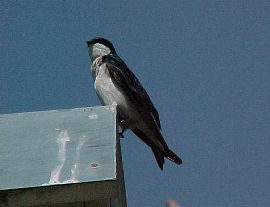Bird Migration
 Birds are lucky in being able to fly and at the end of the summer, when the days are getting shorter and food more scarce, some species fly off to a warmer climate. The swallow is perhaps the best known of all migrant bird species. Flocks of swallows arrive in Britain in late spring, having flown all the way from southern Africa. They then spend the summer here, raising two or three broods, and then flock together for the return journey. Like its close relative, the house martin, the swallow is well-adapted for long-distance flight, having a streamlined body and narrow, curved wings.
Birds are lucky in being able to fly and at the end of the summer, when the days are getting shorter and food more scarce, some species fly off to a warmer climate. The swallow is perhaps the best known of all migrant bird species. Flocks of swallows arrive in Britain in late spring, having flown all the way from southern Africa. They then spend the summer here, raising two or three broods, and then flock together for the return journey. Like its close relative, the house martin, the swallow is well-adapted for long-distance flight, having a streamlined body and narrow, curved wings.
Many birds stay in Britain during the winter, some of them having flown in from their northern breeding grounds (perhaps Russia, Greenland, Scandinavia or the Arctic) to avoid the extremely cold conditions of those places. Although some blackbirds, song thrushes and starlings are resident birds, i.e. they spend the whole year in Britain, others flock into the country from northern climes to enjoy our comparatively mild winter. Other winter migrants include redwings, fieldfares and bramblings. Wild fruits and seeds of all kinds are an important source of food for all these birds, and they fluff out their features on cold days to help keep themselves warm. Many species of water fowl and waders also flock to our shores to find ice-free water and mud-flats.
